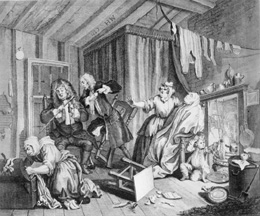


LouisbourgBlog
Website Design and Content © 2008 by Eric
Krause, Krause House Info-Research Solutions (© 1996)
All Images ©
Parks Canada Unless Otherwise Designated
Researching the
Fortress of Louisbourg National Historic Site of Canada
Recherche sur la Forteresse-de-Louisbourg Lieu historique national du Canada
Search All Sites/All Menus ~
Cherche Tous les Sites/Tous les Menus
Louisbourg Blog



POSTING OUR THOUGHTS
[Posted 2/18/2008]
|
HISTORICAL AUTHENTICITY |
The Louisbourg Restoration Project (1961-1982) was unique in the history of Canadian reconstruction. In particular, the multi-disciplinary approach that it observed in the decision making process was a departure from previous practice. In an attempt to cement together this unusual alliance, the project placed a common goal before the different groups: each was to contribute to an accurate as possible, partial rebuilding of 18th Century Louisbourg.
To achieve total authenticity would have been to replicate, 100 percent accurately and without any exceptions, the line, level and fabric of structures and landscapes slated for reconstruction. As a working principle, however, few regarded such a concept as realistic. More important to the course of future events was the project's decision to adhere to a less dogmatic benchmark that called for rebuilding as acurrately as possible. Being a general standard, and without detailed definition, compliance with it unfortunately only served to personalize the meaning of authenticity, and then to congeal the various views around certain factions.
As a result, not one but rather many meanings for what constituted an authentic product were to come to the surface. Contributing to this confusion, the authenticity standard allowed for modern intrusions, normally in hidden places. At any time, for reasons of cost, sound engineering and public safety, compromise was always a possibility, to the degree deemed necessary. Without any measurable standard to limit the extent of such interventions, the only control in these instances was the exercise of common sense within the context of rebuilding Louisbourg as accurately as possible.
In essence, then, what constituted an acceptable level of compromise for rebuilt Louisbourg became the battlefield. At one extreme of the authenticity question were those whose first instinct was to try to minimize the number and effect of such interventions. At the other end were those who felt comfortable with compromise as a necessary evil. With all of them vying for the ear of their superior, political pragmatism proved to be the decision maker in the end. Louisbourg was to be rebuilt within budget; productivity was to be the measure; compromise the tool.
From the beginning of the project to the present day, the research component has been both the guardian of the historical record and the project's most vocal critic concerning compromise. On occasion, it has even convinced the decision makers to permit it time to gather pertinent evidence to ensure historical correctness. Ironically, such proposals provided the opportunity for some to reproach the historical programme with the charge that it was slowing down the progress of reconstruction. This action even though Research was clearly adhering to its assigned mandate.
Since 1961 it has been motherhood to state that the key to accuracy was research and that the work in progress was "authentic." In reality, however, both claims were illusory because of the need to compromise. For this reason, the project frequently chose not to apply the factual evidence that Research had supplied.
Discovering how the project used evidence in reconstructing the Fortress of Louisbourg is to unmask what the operating meaning of authenticity was during the developmental phase. Upon examining it, the maintenance programme can take guidance. By definition, the repair of reconstructed structures and landscapes involves the continual responsibility of being as historically accurate as possible. At the same time, this programme, like that of reconstruction before it, deserves a more precise standard, one with value definitions, for determining an acceptable level of authenticity.
Otherwise, the former meaning will simply continue the debate as to what constitutes proper compromise. In fact, this dispute may even give rise to a more fundamental questioning of reconstruction philosophy itself, and of the emphasis which reconstruction places upon the need to be historically accurate. As in the past, cost is once again a concern. The Fortress site requires widespread repair, and the bill will be substantial. As these prices become known, the temptation to compromise even further will grow stronger. If such interventions are entertained to any degree, the real danger is that at some point in time any resemblance between 18th Century Louisbourg and its supposed replica will be purely accidental.